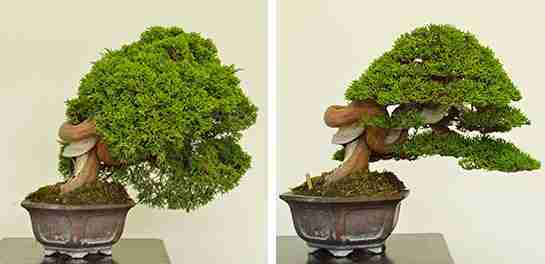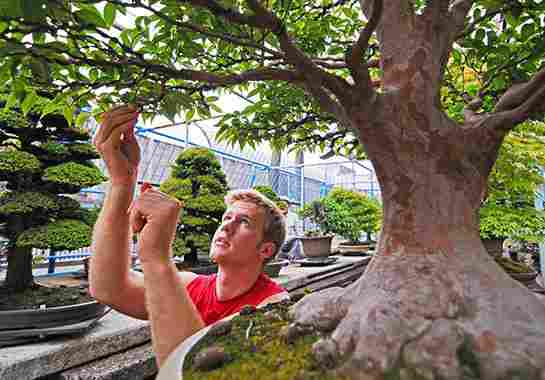Most teenage boys have sports, girls, or some combination of the two on their minds. Bjorn Bjorholm, however, was obsessed with bonsai, ever since he saw one of the Karate Kid movies. “I got my first tree when I was 13—and then killed it within the first three months,” says the Knoxville, Tennessee, native. “I carried around a bonsai book all the time, too, so I was made hard-core fun of in middle school.” He also played the trombone, which didn’t help matters.
Today the 28-year-old newlywed and his Chinese-born wife, Nanxi Chen, live in Osaka, Japan, where he owns and operates Bjorvala Bonsai Studio, teaches at the Fujikawa International School of Bonsai, and has become one of the ancient tree-training art form’s most promising and unlikely faces. The tall, blond, all-American Bjorholm—some swoony followers of his Facebook page and endearing YouTube videos privately refer to him as the Brad Pitt of bonsai—was 16 when he traveled to Japan as part of a student group. There he finagled a meeting with bonsai master Keiichi Fujikawa, who was amused by the American youth’s passion for an Asian art form more than a millennium old. “If you want to be an apprentice, come back,” Fujikawa told him. The Japanese expert was joking, but Bjorholm took the comment seriously.

College followed, as did studies abroad. And all the while Bjorholm kept peppering Fujikawa with letters reminding him of their meeting and his desire to work for him. The volume of correspondence was impressive, but the bonsai master still wasn’t convinced: “I think he figured my language skills were not up to par and was concerned about my work ethic.” Eventually a three-month trial period was arranged in 2008. “I’ve been there ever since,” Bjorholm says, adding that the typical apprenticeship lasts five years. After one more year, he can be certified by the Nippon Bonsai Association.
Fujikawa’s school and nursery is a heart-stopping forest of hundreds of cloudlike, twisted, and cascading trees that tradition dictates can range in size from shockingly tiny examples known as keshitsubo to very large imperial bonsai as tall as Bjorholm himself. When he first arrived, Bjorholm says, conversation with Fujikawa was conducted through “pointing and grunting.” Today Bjorholm is fluent in Japanese, “though some days are better than others.” And, he admits, when it comes to his life’s work, mistakes have been made, the most dreadful being when he accidentally snapped off a picturesque and highly important deadwood branch on a bonsai that had taken his employer years to perfect. “My heart sank because I knew he was going to tell me to go home,” Bjorholm says. Instead Fujikawa, his face a furious red, simply turned and walked away and refused to talk to his American apprentice for weeks.
Trees destined for the bonsai treatment are either grown from seeds or cuttings or harvested in the wild. The majority end up potted in shallow containers, patiently cultivated, and laboriously pruned and shaped. (Among Bjorholm’s favorites are Pinus parviflora, or Japanese white pine, and Prunus mume, or Japanese flowering apricot.) Branches are wrapped with wet raffia, which acts like a second bark, and then are coiled and stabilized with copper wires, a material that allows them to be bent—slowly, carefully, forcefully—into poetic silhouettes that mimic, among other things, the effects of weather and time.

“It’s all about the movement of the trunk and the placement of the branches,” Bjorholm explains, adding that a bonsai takes decades of subtle shaping and pruning to achieve anything close to perfection. Even then, the work never ends. “People say the only finished bonsai is a dead bonsai—which you never want to happen,” he continues, noting that some bonsai are reportedly more than a thousand years old. “The trees constantly change hands, and that community effort makes bonsai a very special art form. Multiple people will work on the same tree over time, each with a different take on how the tree should be designed.”
To that end, Bjorholm travels to the United States twice a year, trips that are part teaching tour and part maintenance assignment. (He tends trees for several American clients and attends bonsai conclaves like September's national bonsai exhibition in Rochester, New York.) For those bitten by the bonsai bug and planning a trip to Japan, he suggests they head for the great bonsai collections at bonsai master Kunio Kobayashi’s Shunkaen Bonsai Museum in Tokyo, as well as in the nearby suburb of Omiya, which Bjorholm calls “a village of nurseries that function as mini-museums.” Dot not, however, ask to see his personal at-home collection of diminutive trees, because none will be found there. “My wife is supportive of my career, but she doesn’t like to get dirty and hates bugs,” he says with a laugh. “Plus, our backyard is only five feet deep and ten feet wide, just big enough for a clothesline.”
Eventually Bjorholm intends to run a school and a nursery of his own, perhaps in Tennessee, where he and his father, Tom Bjorholm, founded the Knoxville Bonsai Society when the up-and-coming bonsai master was a teen and where they maintain a collection of a hundred-odd trees. Until then, however, the engaging expat has his Ph.D. in economics to complete at Osaka University—and that prized certification to earn.
To learn more about Bjorholm and his craft, see his website , as well as the website of bonsai master Keiichi Fujikawa .
To see some of Bjorholm’s proudest arboreal achievements, check out Architectural Digest’ s exclusive slide show.
__ __
